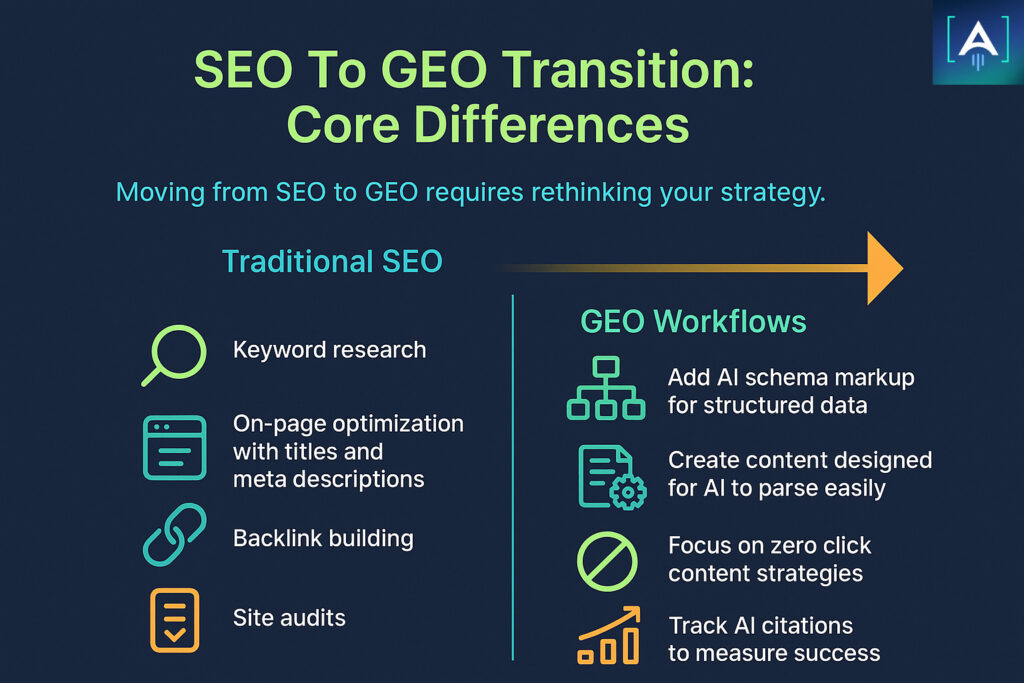Search behavior has shifted. Users ask complete questions, and AI systems answer with short explanations, tables, and named sources. In this world, ranking on a page matters less than being cited inside the answer. Moving from classic SEO to GEO (Generative Engine Optimization) is a shift in mindset, workflow, and measurement.
The Mindset Shift
SEO goal: earn a position on a results page.
GEO goal: earn a citation inside an AI answer.
Key implications
- Smaller unit of value: a paragraph, bullet, or table row that can be lifted.
- Structure as strategy: headings, lists, and concise summaries matter.
- Proof over prose: dates, numbers, and named experts win trust.
Remap Your SEO To A GEO Model
Turn search research into prompt research
- Collect real buyer questions from sales calls, support tickets, and forums.
- Write them verbatim.
- Build a basket of 10 to 20 must win prompts per product or service.
Turn keyword clusters into intent clusters
- Group by task: evaluation, setup, migration, comparison, pricing, compliance.
Turn pillar pages into answer hubs
- Start with a one sentence answer.
- Support with 3 to 5 bullets.
- Finish sections with a 40 to 60 word summary.
- Add a compact FAQ at the end.
Turn backlink outreach into proof building
- Create original data: mini surveys, usage benchmarks, or case datasets.
- Secure quality references from credible publications.
Create Content Models Can Lift
Use an answer first pattern
- One sentence TLDR that directly answers the question.
- Three to five supporting bullets with specifics.
- Two line recap to close the section.
Prefer tables for choices
- Columns for options.
- Rows for attributes.
- A best for row with simple scenarios.
Write question style headings
- “What is,” “How much does it cost,” “When should you use it.”
Make paragraphs self contained
- Two to three sentences per paragraph.
- Repeat key entities by name to avoid ambiguity.
Cite and date claims
- Use recent years and credible sources.
- If using your own data, state the method in one line.

Add The Technical Layer
Give models clean access
- Allow GPTBot, CCBot, PerplexityBot, Claude Web, and Google Extended in robots.txt.
- Keep meaningful text visible without heavy client side rendering.
Use JSON LD schema
- Article for long form resources.
- FAQPage for Q and A sections.
- HowTo for step sequences.
- Product for commercial pages.
- Organization and Person for clear entities.
Standardize entities
- Consistent company, product, and feature names across site and profiles.
Keep pages fast and accessible
- Optimize images and layout.
- Ensure mobile clarity and basic accessibility.
Distribute Where Models Already Look
B2B surfaces
- LinkedIn Articles: publish concise long form with tables or checklists.
- YouTube: short explainers with clean transcripts.
Reference sources
- Wikipedia: where notability is met, keep entries current and sourced.
- Industry publications: contribute data backed explainers or op eds.
Communities
- Reddit and Quora: authentic, helpful answers that map to your prompts.
- Review platforms: G2, Capterra, Trustpilot, and niche directories.
Govern For Accuracy
Monthly accuracy review
- Sample prompts and label mentions as correct, partial, or incorrect.
- Track the accuracy rate over time.
Correction workflow
- Update the authoritative page with clear, dated facts.
- Publish a short clarification if needed.
- Distribute the correction on channels models read, such as LinkedIn.
Single source of truth
- Maintain canonical descriptions for products, pricing, features, and positioning.
Quarterly schema check
- Revalidate Article, FAQPage, HowTo, Product, Organization, and Person properties.
Measure Inclusion, Not Only Clicks
Primary GEO metrics
- Citation frequency: how often your brand or URLs are credited.
- Share of answer: your mentions as a percent of total mentions in a fixed prompt set.
- Prompt coverage: count of priority prompts that include you.
- Answer accuracy rate: percent of mentions that describe you correctly.
- Sentiment of mentions: positive, neutral, negative split.
Secondary GEO metrics
- AI referred traffic: sessions following AI exposure.
- Branded search uplift: growth in brand queries after citation gains.
- Time to inclusion: days from publish or update to first citation.
Team Enablement
Train for answer first writing
- Convert dense sections into answer sentence, supporting bullets, and short recap.
Equip editors with a GEO checklist
- Question style headings, concise paragraphs, dated citations, a table where needed, correct schema.
Make authors visible
- Real names, credentials, and Person schema on author pages.
Add AI QA to pre publish
- Test a few relevant prompts in major engines and adjust structure based on what gets lifted.
A Three Month Transition Plan
Week 1
- Choose one monitoring tool and add your brand and three competitors.
- Define 10 to 20 prompts per product or service.
- Fix robots.txt for AI crawlers.
- Audit your top ten pages and select five for immediate fixes.
Weeks 2 to 4
- Add FAQPage schema to homepage, key product pages, and top posts.
- Restructure five weak pages with answer first sections.
- Publish two comparison pages with a table and a best for row.
- Update author bios with real credentials and Person schema.
- Weekly QA across AI surfaces to see what is being lifted.
Month 2
- Optimize ten more pages.
- Publish one definition page with a precise one line definition, example, and checklist.
- Release one mini data asset and summarize it in a LinkedIn Article.
Month 3
- Optimize another five to ten pages.
- Produce a short YouTube explainer with a transcript.
- Contribute five helpful answers in relevant Reddit or Quora threads.
- Review metrics and close prompt coverage gaps.
Common Pitfalls To Avoid
- Long prefaces that bury the answer.
- Vague headings that hide intent.
- Claims without dates or sources.
- Anonymous authors without credentials.
- Relying only on your blog for distribution.
- Treating schema as an afterthought instead of a meaning label.
What Success Looks Like
- More citations inside answers for your priority prompts.
- Faster inclusion after publishing or updates.
- Higher intent sessions even if total traffic is flat.
- Dashboard conversations that include share of answer and accuracy, not only clicks.
Conclusion: Why Partner With Azarian Growth Agency
If SEO is your foundation, Azarian Growth Agency adds the GEO layer that gets your brand named, quoted, and trusted inside AI answers.
What we deliver
- Strategy and baselines: prompt baskets, citation audits, and share of answer benchmarks.
- Page level optimization: answer first rewrites, tables and FAQs, Article and FAQPage schema, clean entity standards.
- Authority assets: original data and benchmarks that position you as a primary source.
- Distribution programs: LinkedIn Articles, YouTube with transcripts, eligible Wikipedia entries, and credible community participation.
- Measurement and iteration: citations, share of answer, prompt coverage, accuracy, AI referred traffic, and branded search uplift with monthly actions tied to each metric.
What you can expect in the first 90 days
- Faster time to inclusion on priority prompts.
- Rising citation frequency and share of answer.
- Clearer, more accurate descriptions of your products in AI answers.
- Fewer but higher intent visits that convert.
Ready to move from rankings to AI visibility. Let us make your brand the answer.

